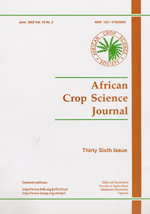
|
African Crop Science Journal
African Crop Science Society
ISSN: 1021-9730
EISSN: 1021-9730
Vol. 4, No. 1, 1996, pp. 41-49
|
 Bioline Code: cs96038
Bioline Code: cs96038
Full paper language: English
Document type: Research Article
Document available free of charge
|
|
|
African Crop Science Journal, Vol. 4, No. 1, 1996, pp. 41-49
| fr |
Ugen, M.A. & Wien, H.C.
Résumé
Un champ experimental etait conduit a l'Universite de Cornell,
New York aux Etats Unis au cours de 2 saisons culturales en 1990 et
1991 pour determiner l'effet des proportions de haricot et de
mais et de l'azote sur l'attaque des insectes, la morphologie,
la competition et les avantages en rendement de 2 cultures
plantees en association. La culture mixte reduisait
l'incidence de coleopteres "Japanese beetles" (Popillia
japanica) et de coleopteres d'haricot "Mexican" (Epilachna
varivestis Mulcant) comparee au haricot en monoculture. Les
deux insectes decroissaient avec la reduction de l'haricot
dans la culture mixte. Le mais plante en monoculture
fleurissait et arrivait plus tot en maturite que le mays en
culture mixte au cours de 2annees. L'application de l'azote
entrainait une floraison precoce du mais. La croissance
vegetative de haricot etait plus grande et la maturite etait
retardee par les taux d'azote tres eleves. La competitivite de
mais ou de l'haricot croissait ou decroissait selon les
proportions culturales tandis que la competitivite de mais
croissait avec le niveau d'azote. Les rapports d'utilisation
de la terre ou Land Equivalent Ratios (LERs) etaient plus
grands pour la culture mixte que pour la culture pure dans les
2 saisons. Les LERs etaient egalement plus grands, en absence
d'application d'azote, ce qui suggere la meilleure utilisation
des nutriments du sol par la culture mixte.
Mots Clés
Coleoptere d'haricot, rapport de competitivite, culture mixte, rapport d'utilisation de la terre, serie de remplacement, monoculture
|
| |
| en |
The Effect of Mixture Proportions and Fertilizer Nitrogen on Morphology, Insect Pest Damage, Competition and Yield Advantages in a Maize/Bean Intercrop
Ugen, M.A. & Wien, H.C.
Abstract
A field experiment was conducted at Cornell University, New
York, USA during 1990 and 1991 growing seasons to determine
the effect of the proportions of beans and maize and of
nitrogen on insect pest damage, morphology, competition and
yield advantages of the two crops grown in mixtures. Inter-
cropping reduced the incidence of Japanese beetles
(Popillia japanica) and Mexican bean beetles
(Epilachna varivestis Mulcant) compared to sole beans.
Both bean beetles decreased with decrease in bean proportion
in the mixtures. Sole maize tasseled and matured earlier than
intercropped maize in both years. Nitrogen application
resulted in earlier maize tasseling. Bean vegetative growth
was greater and maturity delayed the higher the nitrogen
rates. Competitiveness of either maize or beans increased with
decrease in crop proportions and maize competitiveness
increased with increasing N level. Land Equivalent Ratios
(LERs) were greater for intercropping than for sole cropping
in both years. LERs were also higher without N application
suggesting better utilisation of soil nutrients by
intercrops.
Keywords
Bean beetles, competitive ratio, intercropping, land equivalent ratio, replacement series, sole cropping
|
| |
© Copyright 1996 - African Crop Science Society
|
|
